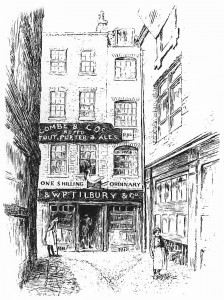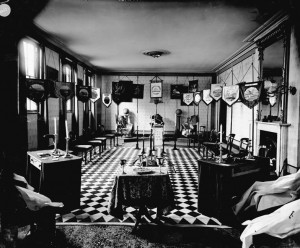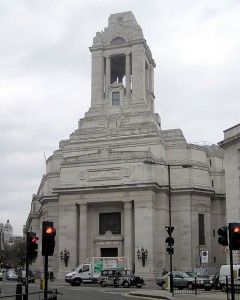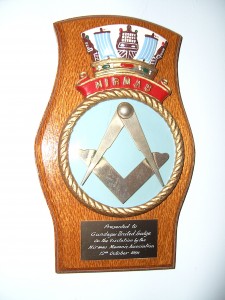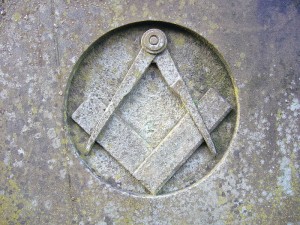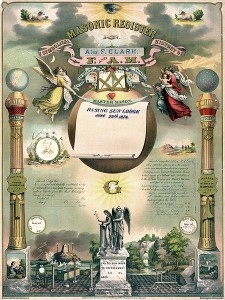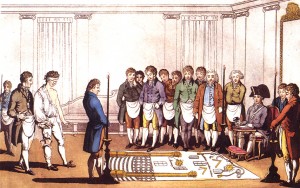
History of Freemasonry
The first Grand Lodge, the Grand Lodge of England (GLE), was founded on 24 June 1717, when four existing London Lodges met for a joint dinner. This rapidly expanded into a regulatory body, which most English Lodges joined. However, a few lodges resented some of the modernisations that GLE endorsed, such as the creation of the Third Degree, and formed a rival Grand Lodge on 17 July 1751, which they called the “Antient Grand Lodge of England.” The two competing Grand Lodges vied for supremacy – the “Moderns” (GLE) and the “Antients” (or “Ancients”) – until they united on 25 November 1813 to form the United Grand Lodge of England (UGLE).
The Grand Lodge of Ireland and The Grand Lodge of Scotland were formed in 1725 and 1736 respectively. Freemasonry was exported to the British Colonies in North America by the 1730s – with both the “Antients” and the “Moderns” (as well as the Grand Lodges of Ireland and Scotland) chartering offspring, or “daughter,” Lodges, and organising various Provincial Grand Lodges. After the American Revolution, independent U.S. Grand Lodges formed themselves within each state. Some thought was briefly given to organising an over-arching “Grand Lodge of the United States,” with George Washington (who was a member of a Virginian lodge) as the first Grand Master, but the idea was short-lived. The various state Grand Lodges did not wish to diminish their own authority by agreeing to such a body.
Although there are no real differences in the Freemasonry practiced by lodges chartered by the Antients or the Moderns, the remnants of this division can still be seen in the names of most Lodges, F.& A.M. being Free and Accepted Masons and A.F.& A.M. being Antient Free and Accepted Masons.
The oldest jurisdiction on the continent of Europe, the Grand Orient de France (GOdF), was founded in 1728. However, most English-speaking jurisdictions cut formal relations with the GOdF around 1877 – when the GOdF removed the requirement that its members have a belief in a Deity, thereby accepting atheists. The Grande Loge Nationale Française (GLNF) is currently the only French Grand Lodge that is in regular amity with the UGLE and its many concordant jurisdictions worldwide.
Due to the above history, Freemasonry is often said to consist of two branches not in mutual regular amity:
- The UGLE and concordant tradition of jurisdictions (mostly termed Grand Lodges) in amity, and
- The GOdF, European Continental, tradition of jurisdictions (often termed Grand Orients) in amity.
In most Latin countries, the GOdF-style of European Continental Freemasonry predominates,[citation needed] although in most of these Latin countries there are also Grand Lodges that are in regular amity with the UGLE and the worldwide community of Grand Lodges that share regular “fraternal relations” with the UGLE. The rest of the world, accounting for the bulk of Freemasonry, tends to follow more closely to the UGLE style, although minor variations exist.
Organizational Structure
Grand Lodges and Grand Orients are independent and sovereign bodies that govern Masonry in a given country, state, or geographical area (termed a jurisdiction). There is no single overarching governing body that presides over worldwide Freemasonry; connections between different jurisdictions depend solely on mutual recognition.
Regularity
Regularity is a constitutional mechanism whereby Grand Lodges or Grand Orients give one another mutual recognition. This recognition allows formal interaction at the Grand Lodge level, and gives individual Freemasons the opportunity to attend Lodge meetings in other recognised jurisdictions. Conversely, regularity proscribes interaction with Lodges that are irregular. A Mason who visits an irregular Lodge may have his membership suspended for a time, or he may be expelled. For this reason, all Grand Lodges maintain lists of other jurisdictions and lodges they consider regular.
Grand Lodges and Grand Orients that afford mutual recognition and allow intervisitation are said to be in amity. As far as the UGLE is concerned, regularity is predicated upon adherence to a number of fundamental principals (known as Landmarks), set down in the UGLE Constitution and the Constitutions of those Grand Lodges with which they are in amity. Even within this definition there are some variations with the quantity and content of the Landmarks from jurisdiction to jurisdiction. Other Masonic groups organise differently.
Each of the two major branches of Freemasonry considers the Lodges within its branch to be “regular” and those in the other branch to be “irregular.” As the UGLE branch is significantly larger, however, the various Grand Lodges and Grand Orients in amity with UGLE are commonly referred to as being “regular” (or “Mainstream”) Masonry, while those Grand Lodges and Grand Orients in amity with GOdF are commonly referred to “liberal” or “irregular” Masonry. (The issue is complicated by the fact that the usage of “Lodge” versus “Orient” alone is not an indicator of which branch a body belongs to, and thus not an indication of regularity). The term “irregular” is also universally applied to various self created bodies that call themselves “Masonic” but are not recognised by either of the main branches.
Masonic Lodge
A Lodge (often termed a Private Lodge or Constituent Lodge in Masonic constitutions) is the basic organisational unit of Freemasonry. Every new Lodge must have a Warrant or Charter issued by a Grand Lodge, authorising it to meet and work. Except for the very few “time immemorial” Lodges pre-dating the formation of a Grand Lodge, masons who meet as a Lodge without displaying this document (for example, in prisoner-of-war camps) are deemed “Clandestine” and irregular.
A Lodge must hold regular meetings at a fixed place and published dates. It will elect, initiate and promote its members and officers; it will build up and manage its property and assets, including its minutes and records; and it may own, occupy or share its premises. Like any organisation, it will have formal business to manage its meetings and proceedings, annual general meetings and committees, charity funds, correspondence and reports, membership and subscriptions, accounts and tax returns, special events and catering, and so forth. The balance of activities is individual to each Lodge, and under their common constitutions and forms of procedure, Lodges evolve very distinctive traditions.
A man can only be initiated, or made a Mason, in a Lodge, of which he may often remain a subscribing member for life. A Master Mason can generally visit any Lodge meeting under any jurisdiction in amity with his own, and as well as the formal meeting, a Lodge may well offer hospitality. A visitor should first check the regularity of that Lodge, and must be able to satisfy that Lodge of his own regularity; and he may be refused admission if adjudged likely to disrupt the harmony of the Lodge. If he wishes to visit the same Lodge repeatedly, he may be expected to join it and pay a subscription.
This plaque commemorates a ‘formal’ fraternal visit by NIRMAS, the Masonic association for members of the Royal Australian Navy, that originally stated at the Apprentice Training Base, HMAS Nirimba, hence the name. The plaque is styled after the ship’s badge for the Navy. The visit was to Lodge Gundagai United, No.25.
Most Lodges consist of Freemasons living or working within a given town or neighborhood. Other Lodges are composed of Masons with a particular shared interest, profession or background. Shared schools, universities, military units, Masonic appointments or degrees, arts, professions and hobbies have all been the qualifications for such Lodges. In some Lodges, the foundation and name may now be only of historic interest, as over time the membership evolves beyond that envisaged by its “founding brethren”; in others, the membership remains exclusive.
There are also specialist Lodges of Research, with membership drawn from Master Masons only, with interests in Masonic Research (of history, philosophy, etc.). Lodges of Research are fully warranted but, generally, do not initiate new candidates. Lodges of Instruction in UGLE may be warranted by any ordinary Lodge for the learning and rehearsal of Masonic Ritual.
Freemasons correctly meet as a Lodge, not in a Lodge, the word “Lodge” referring more to the people assembled than the place of assembly. However, in common usage, Masonic premises are often referred to as “Lodges”. Masonic buildings are also sometimes called “Temples” (“of Philosophy and the Arts”). In many countries, Masonic Centre or Hall has replaced Temple to avoid arousing prejudice and suspicion. Several different Lodges, as well as other Masonic or non-Masonic organizations, often use the same premises at different times.
According to Masonic tradition, medieval European stonemasons would meet, eat, and shelter outside working hours in a Lodge on the southern side of a building site, where the sun warms the stones during the day. The social Festive Board (or Social Board)[16] part of the meeting is thus sometimes called the South. Early Lodges often met in a tavern or any other convenient fixed place with a private room.
Lodge Officers
Every Masonic Lodge elects certain officers to execute the necessary functions of the lodge’s work. The Worshipful Master (essentially the lodge President) is always an elected officer. Most jurisdictions will also elect the Senior and Junior Wardens (Vice Presidents), the Secretary and the Treasurer. All lodges will have a Tyler, or Tiler, (who guards the door to the lodge room while the lodge is in session), sometimes elected and sometimes appointed by the Master. In addition to these elected officers, lodges will have various appointed officers – such as Deacons, Stewards, and a Chaplain (appointed to lead a non-denominational prayer at the convocation of meetings or activities – often, but not necessarily, a clergyman). The specific offices and their functions vary between jurisdictions.
Many offices are replicated at the Provincial and Grand Lodge levels with the addition of the word ‘Grand’ somewhere in the title. For example, where every lodge has a ‘Junior Warden’, Grand Lodges have a ‘Grand Junior Warden’ (or sometimes ‘Junior Grand Warden’). Additionally, there are a number of offices that exist only at the Grand Lodge level.
Other Degrees, Orders and Bodies
There is no degree in Freemasonry higher than that of Master Mason, the Third Degree.[21] There are, however, a number of organizations that require being a Master Mason as a prerequisite for membership. These bodies have no authority over the Craft.[21] These orders or degrees may be described as additional or appendant, and often provide a further perspective on some of the allegorical, moral and philosophical content of Freemasonry.
Appendant bodies are administered separately from Craft Grand Lodges but are styled Masonic since every member must be a Mason. However, Craft Masonic jurisdictions vary in their relationships with such bodies, if a relationship exists at all. The Articles of Union of the “Modern” and “Ancient” craft Grand Lodges (into UGLE in 1813) limited recognition to certain degrees, such as the Royal Arch and the “chivalric degrees”, but there were and are many other degrees that have been worked since before the Union. Some bodies are not universally considered to be appendant bodies, but rather separate organizations that happen to require prior Masonic affiliation for membership. Some of these organizations have additional requirements, such as religious adherence (e.g., requiring members to profess Trinitarian Christian beliefs) or membership of other bodies.
Quite apart from these, there are organizations that are often thought of as being related to Freemasonry, but which have no formal or informal connections with Freemasonry. These include such organizations as the Orange Order, which originated in Ireland, the Knights of Pythias, or the Independent Order of Odd Fellows.
Prince Hall Freemasonry
Prince Hall Freemasonry derives from historical events in the early United States that led to a tradition of separate, predominantly African-American Freemasonry in North America.
In 1775, an African-American named Prince Hall[19] was initiated into an Irish Constitution military Lodge then in Boston, Massachusetts, along with fourteen other African-Americans, all of whom were free-born. When the military Lodge left North America, those fifteen men were given the authority to meet as a Lodge, form Processions on the days of the Saints John, and conduct Masonic funerals, but not to confer degrees, nor to do other Masonic work. In 1784, these individuals applied for, and obtained, a Lodge Warrant from the Premier Grand Lodge of England (GLE) and formed African Lodge, Number 459. When the United Grand Lodge of England (UGLE) was formed in 1813, all U.S.-based Lodges were stricken from their rolls – due largely to the War of 1812. Thus, separated from both UGLE and any concordantly recognised U.S. Grand Lodge, African Lodge re-titled itself as the African Lodge, Number 1 – and became a de facto “Grand Lodge” (this Lodge is not to be confused with the various Grand Lodges on the Continent of Africa). As with the rest of U.S. Freemasonry, Prince Hall Freemasonry soon grew and organized on a Grand Lodge system for each state.
Widespread segregation in 19th- and early 20th-century North America made it difficult for African-Americans to join Lodges outside of Prince Hall jurisdictions – and impossible for inter-jurisdiction recognition between the parallel U.S. Masonic authorities.
Prince Hall Masonry has always been regular in all respects except constitutional separation, and this separation has diminished in recent years. At present, Prince Hall Grand Lodges are recognzised by some UGLE Concordant Grand Lodges and not by others, but they appear to be working toward full recognition, with UGLE granting at least some degree of recognition. There are a growing number of both Prince Hall Lodges and non-Prince Hall Lodges that have ethnically diverse membership.
Principles and Activities
While Freemasonry has often been called a “secret society,” Freemasons themselves argue that it is more correct to say that it is an esoteric society, in that certain aspects are private. The most common phrasing is that Freemasonry has, in the 21st century, become less a secret society and more of a “society with secrets.” The private aspects of modern Freemasonry are the modes of recognition amongst members and particular elements within the ritual. Despite the organization’s great diversity, Freemasonry’s central preoccupations remain charitable work within a local or wider community, moral uprightness (in most cases requiring a belief in a supreme being) as well as the development and maintenance of fraternal friendship, as James Anderson’s Constitutions originally urged amongst brethren.
Ritual, Symbolism, and Morality
Masons conduct their meetings using a ritualised format. There is no single Masonic ritual, and each jurisdiction is free to set (or not set) its own ritual. However, there are similarities that exist among jurisdictions. For example, all Masonic ritual makes use of the architectural symbolism of the tools of the medieval operative stonemason. Freemasons, as speculative masons (meaning philosophical building rather than actual building), use this symbolism to teach moral and ethical lessons of the principles of “Brotherly Love, Relief, and Truth;” or as related in France, “Liberty, Equality, Fraternity.”
Two of the principal symbolic tools always found in a Lodge are the square and compasses. Some Lodges and rituals explain these tools as lessons in conduct: for example, that Masons should “square their actions by the square of virtue” and to learn to “circumscribe their desires and keep their passions within due bounds toward all mankind.” However, as Freemasonry is non-dogmatic, there is no general interpretation for these tools (or any Masonic emblem) that is used by Freemasonry as a whole.
These moral lessons are communicated in performance of allegorical ritual. A candidate progresses through degrees gaining knowledge and understanding of himself, his relationship with others and his relationship with the Supreme Being (per his own interpretation). While the philosophical aspects of Freemasonry tend to be discussed in Lodges of Instruction or Research, and sometimes informal groups, Freemasons, and others, frequently publish, with varying degrees of competence, studies that are available to the public. Any mason may speculate on the symbols and purpose of Freemasonry, and indeed all masons are required to some extent to speculate on masonic meaning as a condition of advancing through the degrees. There is no one accepted meaning, and no one person “speaks” for the whole of Freemasonry.
Some lodges make use of tracing boards. These are painted or printed illustrations depicting the various symbolic emblems of Freemasonry. They can be used as teaching aids during the lectures that follow each of the three Degrees, when an experienced member explains the various concepts of Freemasonry to new members. They can also be used by experienced members as self-reminders of the concepts they learned as they went through their initiations.
The Supreme Being and the Volume of Sacred Law
Candidates for regular Freemasonry are required to declare a belief in a Supreme Being. However, the candidate is not asked to expand on, or explain, his interpretation of Supreme Being. The discussion of politics and religion is forbidden within a Masonic Lodge, in part so a Mason will not be placed in the situation of having to justify his personal interpretation. Thus, reference to the Supreme Being can mean the Christian Trinity to a Christian Mason, Allah to a Muslim Mason, Para Brahman to a Hindu Mason, etc. While most Freemasons would take the view that the term Supreme Being equates to God, others may hold a more complex or philosophical interpretation of the term.
In the ritual, the Supreme Being is referred to as the Great Architect of the Universe, which alludes to the use of architectural symbolism within Freemasonry.
A Volume of the Sacred Law is always displayed in an open Lodge in those jurisdictions which require a belief in the Supreme Being. In English-speaking countries, this is frequently the King James Version of the Bible or another standard translation; there is no such thing as an exclusive “Masonic Bible.” Furthermore, a candidate is given his choice of religious text for his Obligation, according to his beliefs. UGLE alludes to similarities to legal practice in the UK, and to a common source with other oath taking processes. In Lodges with a membership of mixed religions it is common to find more than one sacred text displayed. In lodges that follow the Continental tradition other texts may be used, including texts that are non-religious in nature.
Degrees
In the 19th century, certificates such as this were commonly issued to Masons to show that they had taken the three degrees of Craft Masonry in a regular lodge
The three degrees of Craft or Blue Lodge Freemasonry are those of:
1. Entered Apprentice – the degree of an Initiate, which makes one a Freemason;
2. Fellow Craft – an intermediate degree, involved with learning; and
3. Master Mason – the “third degree”, a necessity for participation in most aspects of Masonry.
The degrees represent stages of personal development. No Freemason is told that there is only one meaning to the allegories; as a Freemason works through the degrees and studies their lessons, he interprets them for himself, his personal interpretation being bounded only by the Constitution within which he works. A common symbolic structure and universal archetypes provide a means for each Freemason to come to his own answers to life’s important philosophical questions.
There is no degree of Craft Freemasonry higher than that of Master Mason. Although some Masonic bodies and orders have further degrees named with higher numbers, these degrees may be considered to be supplements to the Master Mason degree rather than promotions from it. An example is the Scottish Rite, conferring degrees numbered from 4° up to 33°. It is essential to be a Master Mason in order to qualify for these further degrees. They are administered on a parallel system to Craft or Blue Lodge Freemasonry; within each organization there is a system of offices, which confer rank within that degree or order alone.
In some jurisdictions, especially those in continental Europe, Freemasons working through the degrees may be asked to prepare papers on related philosophical topics, and present these papers in open Lodge. There is an enormous bibliography of Masonic papers, magazines and publications ranging from fanciful abstractions which construct spiritual and moral lessons of varying value, through practical handbooks on organization, management and ritual performance, to serious historical and philosophical papers entitled to academic respect.
Signs, Grips and Words
Freemasons use signs (gestures), grips or tokens (handshakes) and words to gain admission to meetings and identify legitimate visitors.
From the early 18th century onwards, many exposés have been written claiming to reveal these signs, grips and passwords to the uninitiated. A classic response was deliberately to transpose certain words in the ritual, so as to catch out anyone relying on the exposé. However, since each Grand Lodge is free to create its own rituals, the signs, grips and passwords can and do differ from jurisdiction to jurisdiction. Furthermore, Grand Lodges can and do change their rituals periodically, updating the language used, adding or omitting sections. Therefore, any exposé can only be valid for a particular jurisdiction at a particular time, and is always difficult for an outsider to verify. Today, an unknown visitor may be required to produce a certificate, dues card or other documentation of membership in addition to demonstrating knowledge of the signs, grips and passwords.
Obligations
Obligations are those elements of ritual in which a candidate swears to abide by the rules of the fraternity, to keep the “secrets of Freemasonry” (which are the various signs, tokens and words associated with recognition in each degree), and to act towards others in accordance with Masonic tradition and law. In regular jurisdictions these obligations are sworn on the aforementioned Volume of the Sacred Law and in the witness of the Supreme Being and often with assurance that it is of the candidate’s own free will.
Details of the obligations vary; some versions are published while others are privately printed in books of coded text. Still other jurisdictions rely on oral transmission of ritual, and thus have no ritual books at all. Moreover, not all printed rituals are authentic – Léo Taxil’s exposure, for example, is a proven hoax, while Duncan’s Masonic Monitor (created, in part, by merging elements of several rituals then in use) was never adopted by any regular jurisdiction.
Whilst no single obligation is representative of Freemasonry as a whole, a number of common themes appear when considering a range of potential texts. Content which may appear in at least one of the three obligations includes: the candidate promises to act in a manner befitting a member of civilized society, promises to obey the law of his Supreme Being, promises to obey the law of his sovereign state, promises to attend his lodge if he is able, promises not to wrong, cheat nor defraud the Lodge or the brethren, and promises aid or charity to a member of the human family, brethren and their families in times of need if it can be done without causing financial harm to himself or his dependents.
The obligations are historically known amongst various sources critical of Freemasonry for their so-called “bloody penalties,” an allusion to the apparent physical penalties associated with each degree. This leads to some descriptions of the Obligations as “Oaths”. The corresponding text, with regard to the penalties, does not appear in authoritative, endorsed sources, following a decision “that all references to physical penalties be omitted from the obligations taken by Candidates in the three Degrees and by a Master Elect at his Installation but retained elsewhere in the respective ceremonies.” The penalties are interpreted symbolically, and are not applied in actuality by a Lodge or by any other body of Masonry. The descriptive nature of the penalties alludes to how the candidate should feel about himself should he knowingly violate his obligation. Modern actual penalties may include suspension, expulsion or reprimand.
Landmarks
The Landmarks of Masonry are defined as ancient and unchangeable principles; standards by which the regularity of Lodges and Grand Lodges are judged. Each Grand Lodge is self-governing and no single authority exists over the whole of Freemasonry. The interpretation of these principles therefore can and does vary, leading to controversies of recognition.
The concept of Masonic Landmarks appears in Masonic regulations as early as 1723, and seems to be adopted from the regulations of operative masonic guilds. In 1858, Albert G. Mackey attempted to set down 25 Landmarks. In 1863, George Oliver published a Freemason’s Treasury in which he listed 40 Landmarks. A number of American Grand Lodges have attempted the task of enumerating the Landmarks; numbers differing from West Virginia and New Jersey to Nevada and Kentucky.
Charitable Effort
The fraternity is widely involved in charity and community service activities. In contemporary times, money is collected only from the membership, and is to be devoted to charitable purposes. Freemasonry worldwide disburses substantial charitable amounts to non-Masonic charities, locally, nationally and internationally. In earlier centuries, however, charitable funds were collected more on the basis of a Provident or Friendly Society, and there were elaborate regulations to determine a petitioner’s eligibility for consideration for charity, according to strictly Masonic criteria.
Some examples of Masonic charities include:
▪ Homes that provide sheltered housing or nursing care.
▪ Education with both educational grants or schools such as the Royal Masonic School (UK) which are open to all and not limited to the families of Freemasons.
▪ Medical assistance.
▪ Masonic Child Identification Programs (CHIP).
In addition to these, there are thousands of philanthropic organizations around the world created by Freemasons. The Masonic Service Association, the Masonic Medical Research Laboratory, and the Shriners Hospitals for Children are especially notable charitable endeavours that Masons have founded and continue to support both intellectually and monetarily.
Membership Requirements
Freemasonry initiation. 18th century Contrary to common misconception, joining Freemasonry is not by invitation only. In fact, in many jurisdictions, the brothers of the lodge are not allowed to ask potential candidates to join (in these jurisdictions, the brethren must wait for the potential candidate to inquire).[citation needed] Other jurisdictions allow for varying degrees of solicitation.
However the initial introduction is made, the official process of becoming a Mason begins when a candidate for Freemasonry formally petitions a lodge. The brethren will then investigate the candidate, to assure themselves of his good character, and hold a secret ballot election (often using an old fashioned ballot box). The number of adverse votes needed to reject a candidate varies from jurisdiction to jurisdiction (in some, one “black ball” is enough to reject, in others up to three are required).
General Requirements
Generally, to be accepted for initiation as a regular Freemason, a candidate must:
▪ Be a man who comes of his own free will.
▪ Believe in a Supreme Being (the form of which is left to open interpretation by the candidate).
▪ Be at least the minimum age (from 18–25 years old depending on the jurisdiction. In some jurisdictions the son of a Mason, known as a “Lewis,” may join at an earlier age than others).
▪ Be of good morals, and of good reputation.
▪ Be of sound mind and body (lodges had in the past denied membership to a man because of a physical disability; however, now, if a potential candidate says a disability will not cause problems, it will not be held against him).
▪ Be free-born (or “born free”, i.e., not born a slave or bondsman). As with the previous, this is entirely an historical holdover, and can be interpreted in the same manner as it is in the context of being entitled to write a will. Some jurisdictions have removed this requirement.
▪ Be capable of furnishing character references, as well as one or two references from current Masons, depending on jurisdiction.
Some Grand Lodges in the United States have an additional residence requirement, candidates being expected to have lived within the jurisdiction for a certain period of time, typically six months.
Membership and Religion
Freemasonry explicitly and openly states that it is neither a religion nor a substitute for one. “There is no separate Masonic God”, nor a separate proper name for a deity in any branch of Freemasonry.
Regular Freemasonry requires that its candidates believe in a Supreme Being, but the interpretation of this term is subject to the conscience of the candidate. Consequently, Freemasonry accepts men from a range of faiths, including (but not limited to) Buddhism, Christianity, Hinduism, Islam, Judaism, and Sikhism. As a result, Freemasonry uses Volume of the Sacred Law (VSL) as a generic term for a religious book. As UGLE-based Freemasonry also requires that a VSL be present on the Altar, many Lodges have multiple VSLs available, and a candidate can be obligated on his book of choice.
Since the early 19th century, in the irregular Continental European tradition (meaning irregular to those Grand Lodges in amity with the United Grand Lodge of England), a very broad interpretation has been given to a non-dogmatic Supreme Being; in the tradition of Baruch Spinoza and Johann Wolfgang von Goethe – or views of The Ultimate Cosmic Oneness – along with Western atheistic idealism and agnosticism.
The form of Freemasonry most common in Scandinavia, known as the Swedish Rite, on the other hand, accepts only Christians.
Freemasonry and Women
Since the adoption of Anderson’s constitution in 1723, it has been accepted as fact by regular Masons that only men can be made Masons. Most Grand Lodges do not admit women because they believe it would violate the ancient Landmarks. While a few women, such as Elizabeth Aldworth, were initiated into British speculative lodges prior to 1723, officially regular Freemasonry remains exclusive to men.
While women cannot join regular lodges, there are (mainly within the borders of the United States) many female orders associated with regular Freemasonry and its appendant bodies, such as the Order of the Eastern Star, the Order of the Amaranth, the White Shrine of Jerusalem, the Social Order of Beauceant and the Daughters of the Nile. These have their own rituals and traditions, but are founded on the Masonic model. In the French context, women in the 18th and 19th centuries had been admitted into what were known as “adoption lodges” in which they could participate in ritual life. However, men clearly saw this type of adoption Freemasonry as distinct from their exclusively male variety. From the late 19th century onward, mixed gender lodges have met in France.
In addition, there are many non-mainstream Masonic bodies that do admit both men and women or are exclusively for women. Co-Freemasonry admits both men and women, but it is held to be irregular because it admits women. The systematic admission of women into International Co-Freemasonry began in France in 1882. In more recent times, women have created and maintained separate Lodges, working the same rituals as the all male regular lodges. These Female Masons have founded lodges around the world, and these Lodges continue to gain membership.
Opposition to and Criticism of Freemasonry
Anti-Masonry (alternatively called Anti-Freemasonry) has been defined as “opposition to Freemasonry.” However, there is no homogeneous anti-Masonic movement. Anti-Masonry consists of widely differing criticisms from diverse (and often incompatible) groups who are hostile to Freemasonry in some form. Critics have included religious groups, political groups, and conspiracy theorists.
There have been many disclosures and exposés dating as far back as the 18th century. These often lack context, may be outdated for various reasons, or could be outright hoaxes on the part of the author, as in the case of the Taxil hoax.
These hoaxes and exposés have often become the basis for criticism of Masonry, often religious or political in nature (usually by totalitarian dictatorial regimes, but also arising in the historical Anti-Masonic Party in the United States), or are based on suspicion of corrupt conspiracy of some form. The political opposition that arose after the “Morgan Affair” in 1826 gave rise to the term “Anti-Masonry,” which is still in use today, both by Masons in referring to their critics and as a self-descriptor by the critics themselves.
Religious Opposition
Freemasonry has attracted criticism from theocratic states and organized religions for supposed competition with religion, or supposed heterodoxy within the Fraternity itself, and has long been the target of conspiracy theories, which see it as an occult and evil power.
Christianity and Freemasonry
Although members of various faiths cite objections, certain Christian denominations have had high profile negative attitudes to Masonry, banning or discouraging their members from being Freemasons.
The denomination with the longest history of objection to Freemasonry is the Roman Catholic Church. The objections raised by the Roman Catholic Church are based on the allegation that Masonry teaches a naturalistic deistic religion which is in conflict with Church doctrine. A number of Papal pronouncements have been issued against Freemasonry. The first was Pope Clement XII’s In Eminenti, 28 April 1738; the most recent was Pope Leo XIII’s Ab Apostolici, 15 October 1890. The 1917 Code of Canon Law explicitly declared that joining Freemasonry entailed automatic excommunication. The 1917 Code of Canon Law also forbade books friendly to Freemasonry.
In 1983, the Church issued a new Code of Canon Law. Unlike its predecessor, it did not explicitly name Masonic orders among the secret societies it condemns. It states in part: “A person who joins an association which plots against the Church is to be punished with a just penalty; one who promotes or takes office in such an association is to be punished with an interdict.” This omission caused both Catholics and Freemasons to believe that the ban on Catholics becoming Freemasons may have been lifted, especially after the perceived liberalization of Vatican II. However, the matter was clarified when Cardinal Joseph Ratzinger (later Pope Benedict XVI), as the Prefect of the Congregation for the Doctrine of the Faith, issued Quaesitum est, which states: “… the Church’s negative judgment in regard to Masonic association remains unchanged since their principles have always been considered irreconcilable with the doctrine of the Church and therefore membership in them remains forbidden. The faithful who enroll in Masonic associations are in a state of grave sin and may not receive Holy Communion.” Thus, from a Catholic perspective, there is still a ban on Catholics joining Masonic Lodges. For its part, Freemasonry has never objected to Catholics joining their fraternity. Those Grand Lodges in amity with UGLE deny the Church’s claims and state that they explicitly adhere to the principle that “Freemasonry is not a religion, nor a substitute for religion.”
In contrast to Catholic allegations of rationalism and naturalism, Protestant objections are more likely to be based on allegations of mysticism, occultism, and even Satanism. Masonic scholar Albert Pike is often quoted (in some cases misquoted) by Protestant anti-Masons as an authority for the position of Masonry on these issues. However, Pike, although undoubtedly learned, was not a spokesman for Freemasonry and was controversial among Freemasons in general, representing his personal opinion only, and furthermore an opinion grounded in the attitudes and understandings of late 19th century Southern Freemasonry of the USA alone. Indeed his book carries in the preface a form of disclaimer from his own Grand Lodge. No one voice has ever spoken for the whole of Freemasonry.
Free Methodist Church founder B.T. Roberts was a vocal opponent of Freemasonry in the mid 19th century. Roberts opposed the society on moral grounds and stated, “The god of the lodge is not the God of the Bible.” Roberts believed Freemasonry was a “mystery” or “alternate” religion and encouraged his church not to support ministers who were Freemasons. Freedom from secret societies is one of the “frees” the Free Methodist Church was founded upon.
Since the founding of Freemasonry, many Bishops of the Church of England have been Freemasons, such as Archbishop Geoffrey Fisher. In the past, few members of the Church of England would have seen any incongruity in concurrently adhering to Anglican Christianity and practicing Freemasonry. In recent decades, however, reservations about Freemasonry have increased within Anglicanism, perhaps due to the increasing prominence of the evangelical wing of the church. The current Archbishop of Canterbury, Dr Rowan Williams, appears to harbour some reservations about Masonic ritual, whilst being anxious to avoid causing offense to Freemasons inside and outside the Church of England. In 2003 he felt it necessary to apologize to British Freemasons after he said that their beliefs were incompatible with Christianity and that he had barred the appointment of Freemasons to senior posts in his diocese when he was Bishop of Monmouth.
In 1933, the Orthodox Church of Greece officially declared that being a Freemason constitutes an act of apostasy and thus, until he repents, the person involved with Freemasonry cannot partake of the Eucharist. This has been generally affirmed throughout the whole Orthodox Church. The Orthodox critique of Freemasonry agrees with both the Roman Catholic and Protestant versions: “Freemasonry cannot be at all compatible with Christianity as far as it is a secret organization, acting and teaching in mystery and secret and deifying rationalism.”
Regular Freemasonry has traditionally not responded to these claims, beyond the often repeated statement that those Grand Lodges in amity with UGLE explicitly adhere to the principle that “Freemasonry is not a religion, nor a substitute for religion. There is no separate ‘Masonic deity,’ and there is no separate proper name for a deity in Freemasonry.” In recent years, however, this has begun to change. Many Masonic websites and publications address these criticisms specifically.
Islam and Freemasonry
Many Islamic anti-Masonic arguments are closely tied to both Anti-Semitism and Anti-Zionism, though other criticisms are made such as linking Freemasonry to Dajjal. Some Muslim anti-Masons argue that Freemasonry promotes the interests of the Jews around the world and that one of its aims is to rebuild the Temple of Solomon in Jerusalem after destroying the Al-Aqsa Mosque. In article 28 of its Covenant, Hamas states that Freemasonry, Rotary, and other similar groups “work in the interest of Zionism and according to its instructions …”[ Many countries with a significant Muslim population do not allow Masonic establishments within their jurisdictions. However, countries such as Turkey and Morocco have established Grand Lodges, while in countries such as Malaysia and Lebanon there are District Grand Lodges operating under a warrant from an established Grand Lodge. In Pakistan in 1972 Zulfiqar Ali Bhutto, then Prime Minister of Pakistan, placed a ban on Freemasonry and confiscated all the literature. The lodges were then disbanded.[citation needed] Masonic lodges existed in Iraq as early as 1919, when the first lodge under the UGLE was opened in Basra,[citation needed] and later on when the country was under British Mandate just after the First World War. However the position changed in July 1958 following the Revolution, with the abolition of the Monarchy and Iraq being declared a republic, under General Qasim. The licences permitting lodges to meet were rescinded and later laws were introduced banning any further meetings. This position was later reinforced under Saddam Hussein, the death penalty was “prescribed” for those who “promote or acclaim Zionist principles, including freemasonry, or who associate [themselves] with Zionist organizations.” With the fall of the Hussein government in 2003, a number of Lodges have begun to meet on military bases within Iraq. These lodges primarily cater to British and American military units, but a few have initiated Iraqis. Several Grand Lodges have expressed a desire to charter Lodges with completely Iraqi membership in the near future.[citation needed]
The Holocaust
The preserved records of the Reichssicherheitshauptamt (the Reich Security Main Office) show the persecution of Freemasons.[95] RSHA Amt VII (Written Records) was overseen by Professor Franz Six and was responsible for “ideological” tasks, by which was meant the creation of anti-Semitic and anti-Masonic propaganda. While the number is not accurately known, it is estimated that between 80,000 and 200,000 Freemasons were killed under the Nazi regime.citation needed Masonic concentration camp inmates were graded as political prisoners and wore an inverted red triangle.[96]
Forget-me-not
 The small blue forget-me-not flower was first used by the Grand Lodge Zur Sonne, in 1926, as a Masonic emblem at the annual convention in Bremen, Germany. In 1938 the forget-me-not badge – made by the same factory as the Masonic badge – was chosen for the annual Nazi Party Winterhilfswerk, a Nazi charitable organisation which collected money so that other state funds could be freed up and used for rearmament. This coincidence enabled Freemasons to wear the forget-me-not badge as a secret sign of membership.
The small blue forget-me-not flower was first used by the Grand Lodge Zur Sonne, in 1926, as a Masonic emblem at the annual convention in Bremen, Germany. In 1938 the forget-me-not badge – made by the same factory as the Masonic badge – was chosen for the annual Nazi Party Winterhilfswerk, a Nazi charitable organisation which collected money so that other state funds could be freed up and used for rearmament. This coincidence enabled Freemasons to wear the forget-me-not badge as a secret sign of membership.
After World War II, the forget-me-not flower was again used as a Masonic emblem at the first Annual Convention of the United Grand Lodges of Germany in 1948. The badge is now worn in the coat lapel by Freemasons around the world to remember all those that have suffered in the name of Freemasonry, especially those during the Nazi era.


